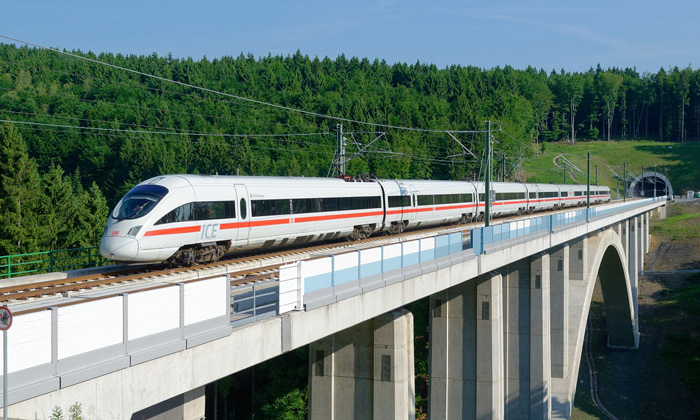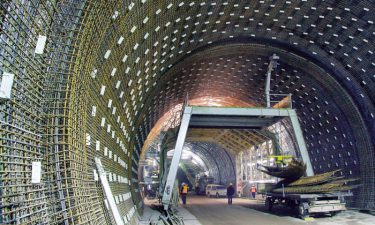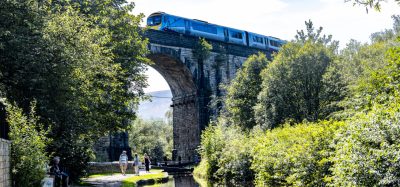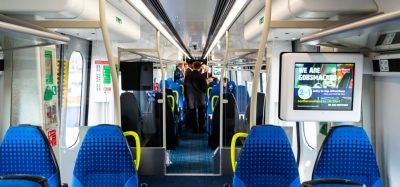Deutsche Bahn now offers Berlin to Munich service in less than four hours
Posted: 14 December 2017 | Global Railway Review | 5 comments
17 million people in Germany will benefit from shorter journey times, new direct services and better connections as Deutsche Bahn (DB) expects its market share on this route to double, reaching a figure of 40 per cent…


Germany’s most modern railway line between Berlin and Munich was inaugurated in Berlin with two special trains. The 500km new-build route from Erfurt to Ebensfeld, which began in 1991, completes the final gap in the German Unification Traffic Projects. From 10 December 2017, 35 ICE trains will run daily on the new line.
“The largest of all German Unification Traffic Projects has now gone into operation,” commented Federal Minister Christian Schmidt. “High-performance infrastructure in all parts of Germany is an essential requirement for the unity of our country. A major and final step has now been accomplished in rail transport. The German Unification Traffic Projects integrate our country, creating new and in-depth human and economic relations.”


45 stations throughout Germany can now be reached directly by ICE via the new high-speed line. Richard Lutz, CEO and Chairman of the Management Board of Deutsche Bahn, labelled the inauguration of the new high-speed line as a milestone: “This superlative railway line has helped Germany to grow closer together. In future, Berlin and Munich will be linked in the record travel time of less than four hours, from city centre to city centre. This service is sure to encourage more people than ever before to travel by rail.”
As the new rail hub in central Germany, Erfurt now offers fast connections in all four directions, with long-distance trains departing every hour. These services have been timed to optimise the connections to regional services so that more distant regions will also benefit from the advantages of the new line.
The Federal Government provided €10 billion to help fund the project. ICE Sprinter trains now travel on both these new-build lines at speeds of 300km/h compared to the limit of 200km/h set in 2006 and 17 million people will experience the benefits from shorter journey times, new direct services and better connections. DB expects its market share on this route to double, reaching a figure of 40 per cent. The new service campaign is part of the quality programme entitled “The Future of Rail Operations in Germany”, with which DB intends to make rail travel more comfortable and dependable.
Related topics
Digitalisation, High-Speed Rail, Infrastructure Developments, Passenger Experience/Satisfaction, Route Development, Station Developments, Track Construction









This project shows a major deficiency of the German high speed network: It is actually not a network. Several stretches of new lines are linked with old slow lines; therefore travel times are usually not too exciting. Add to this the disputes when planning new lines – I can understand environmental issues in a densely populated country, but much worse is the lobbying of local interests. This has led e.g. to the Hanover – Würzburg line making a detour via Göttingen; the Stuttgart – Ulm line will make a detour to the regional airport (not much of a detour, but adding hugely to the cost for very little benefit), and while I don’t know the political history of Munich – Berlin, it looks to me that Erfurt had the best connections to the central government. The new line surely makes a huge difference to the region, but this improvement for one region often goes to the detriment of other regions, and it will be impossible to connect every little region by high-speed rail. In this situation, I often feel it would be better to spend the billions, which go into building new lines, on improving existing lines. The present planning (or absence of it) reminds a little of the situation 150 years ago, where local rulers often insisted on railway lines staying in their principality.
Are you sure about those four hours? Driving a typical German car along that route does the trip in less than that. Certainly with a German driver at the wheel. If that is correct it has a whiff of commercial failure hanging around it.
The ‘typical German car’ might make it after 7 in the evening, but not during daytime. Whenever I went on a German motorway recently, I was often happy if I could sustain 100km/h, because they were choked with traffic.
Paris-Strasbourg is also around 500km. Travel Time: 1h46.
Meh
What is the big deal?
London to Edinburgh is 400 miles so about the same distance and it currently doing the run in about 4hr 20 (although I remember sub 4hours trips not that long ago) whilst many of the locos are over 40 years old on this route. The Ice trains have an operating speed of 300kmh compared to 200kmh on the east Coast mainline. Frankly I was expecting a new line between Munich and Berlin to reduce the time to under 3 hours, probably even under 2hours 30mins for most services. Then the train gets 95% of all trips on this important route. Surely this is doable with the current rolling stock, so it must be a very low speed line that has just been built on the cheap.